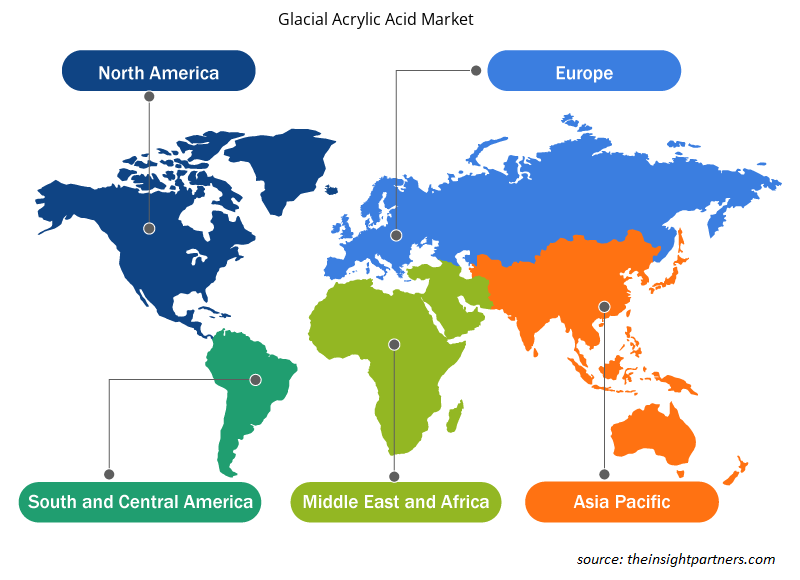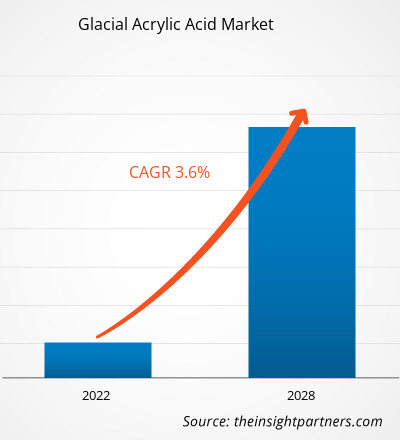2021 年冰丙烯酸市场价值为 26.0767 亿美元,预计到 2028 年将达到 33.5124 亿美元;预计 2021 年至 2028 年的复合年增长率为 3.6%。
冰丙烯酸是一种不饱和羧酸共聚单体。它很容易与丙烯酸和甲基丙烯酸酯、乙烯、醋酸乙烯酯、苯乙烯、丁二烯、丙烯腈、氯乙烯、马来酸酯和偏二氯乙烯共聚。冰丙烯酸主要用作生产酸官能和交联丙烯酸共聚物和聚丙烯酸的基料。冰丙烯酸作为共聚单体在广泛的丙烯酸和乙烯基丙烯酸聚合物基饰面、涂料、密封剂、粘合剂、油墨、增稠剂、絮凝剂和润滑剂等中具有显著的优势。此外,GAA 还用于制造用于从医用水凝胶到高吸水性聚合物再到洗涤剂等各种应用的聚合物。
预测期内,亚太地区占据全球冰丙烯酸市场的最大份额。韩国和中国等新兴国家对婴儿尿布的需求不断增长,推动了对高吸水性聚合物 (SAP) 的需求。此外,冰丙烯酸在粘合剂、涂料、建筑、水处理、洗涤剂、皮革处理和纺织化学品等领域有多种应用。因此,这些因素导致了该地区冰丙烯酸市场的增长。
持续的 COVID-19 疫情彻底改变了冰丙烯酸市场的现状,并对其增长产生了负面影响。由于国家和国际边界突然关闭,疫情降低了运营效率并中断了价值链,从而造成收入损失和损害。价值链的中断限制了原材料的供应,进而阻碍了市场的增长并影响了终端使用行业的发展。然而,随着各经济体计划恢复运营,预计未来几个月全球对冰丙烯酸的需求将上升。随着后疫情时代人们对可持续性和应用基础多样化的意识不断增强,预计未来对冰丙烯酸的需求将大幅增长。据国际金融公司称,COVID-19 疫情预计将减缓全球对水行业的投资。全球水领袖集团的一项调查预测,由于疫情,工业用水需求将下降约 27%。此外,全球水务领袖集团表示,由于 COVID-19 危机,全球水务和污水处理公用事业的收入预计将平均减少 15%。因此,预计水务行业对水处理化学品的需求将下降,这将对冰丙烯酸市场产生负面影响。尽管如此,在政府积极举措的支持下,国际工业织物协会等协会为保护一线医护人员而采取的有效措施预计将提振纺织业,这将在未来几年增加对冰丙烯酸的需求。
定制此报告以满足您的需求
您可以免费定制任何报告,包括本报告的部分内容、国家级分析、Excel 数据包,以及为初创企业和大学提供优惠和折扣
- 获取此报告的关键市场趋势。这个免费样品将包括数据分析,从市场趋势到估计和预测。
市场洞察
尿布和卫生用品中高吸水性聚合物的使用增加
丙烯酸占生产高吸水性树脂 (SAP) 所用原材料的 80-85%。该聚合物由冰丙烯酸与交联单体和引发剂的水溶液聚合而成。高吸水性树脂广泛用于尿布和卫生用品,因为它们可以吸收和保留大量的水和水溶液。SAP 主要由部分中和和轻度交联的聚丙烯酸制成,是女性卫生用品、一次性尿布以及成人失禁产品中不可或缺的成分。全球约 77.5% 的 SAP 用于尿布,9.5% 用于成人失禁产品,4% 用于女性卫生用品。SAP 是丙烯酸价值链中的重要产品,其吸水特性正在增加其在卫生和卫生产品中的需求。此外,主要制造商正专注于生产丙烯酸及其衍生产品,例如丙烯酸酯和高吸水性聚合物。例如,日本触媒株式会社一直在全球范围内拓展其高吸水性聚合物和丙烯酸的核心业务。随着高吸水性聚合物在尿布中的应用不断增加,该公司的 SAP 年产能也强劲增长,这也是该公司的优势所在。因此,高吸水性聚合物市场的增长归因于高吸水性聚合物生产需求的不断增长。此外,民众(尤其是老龄化人口)的卫生意识不断增强,推动了尿布和卫生产品对高吸水性丙烯酸的需求。
应用程序洞察
根据应用,全球冰丙烯酸市场细分为尿布、成人和女性卫生用品、洗涤剂、粘合剂、涂料和密封剂、水处理等。预测期内,尿布部分占据了最大的市场份额。冰(蒸馏)丙烯酸用于高吸水性聚合物 (SAP),后者广泛用于一次性婴儿尿布。高吸水性聚合物是交联聚丙烯酸酯,可吸收和保留超过其自身重量 100 倍的液体。SAP 占全球丙烯酸消费量的 30% 以上。制造商提供冰丙烯酸,它广泛应用于尿布。BASF PETRONAS Chemicals Sdn. Bhd. 提供用于一次性尿布的冰丙烯酸。此外,Tasnee 提供的冰丙烯酸是一种不饱和羧酸,呈无色透明液体,具有特有的刺鼻气味。它可与水、酒精和醚混溶。它用于聚合物制备和作为化学中间体。冰丙烯酸可用于尿布等行业。
陶氏化学公司、阿科玛、巴斯夫 SE、萨索尔、Tasnee、海通化工株式会社、三菱化学株式会社、日本触媒株式会社、台塑株式会社和巴斯夫石油化学有限公司是全球丙烯酸市场的知名参与者。该市场的公司一直专注于产品开发、工厂扩建和并购等战略,以扩大其全球影响力并满足日益增长的市场需求。例如,2019 年,阿科玛在其位于德克萨斯州 Clear Lake 的工厂成功引进了一台年产 90,000 吨的新型丙烯酸反应器。新反应器配备了最新的生产技术,取代了两台已退役的 45,000 吨反应器。这项约 9000 万美元的投资使 Clear Lake 成为美国最具竞争力的丙烯酸工厂之一。这项新产能将使集团能够推动其北美客户在油漆和涂料、高吸水性树脂、粘合剂以及用于水处理和提高油气采收率的聚合物等市场的增长。此外,此次扩张巩固了阿科玛作为该地区第二大丙烯酸生产商的地位。
冰丙烯酸市场区域洞察
Insight Partners 的分析师已详细解释了预测期内影响冰丙烯酸市场的区域趋势和因素。本节还讨论了北美、欧洲、亚太地区、中东和非洲以及南美和中美洲的冰丙烯酸市场细分和地理位置。

- 获取冰丙烯酸市场的区域具体数据
冰丙烯酸市场报告范围
| 报告属性 | 细节 |
|---|---|
| 2021 年市场规模 | 26.1亿美元 |
| 2028 年市场规模 | 33.5亿美元 |
| 全球复合年增长率(2021 - 2028) | 3.6% |
| 史料 | 2019-2020 |
| 预测期 | 2022-2028 |
| 涵盖的领域 | 按应用
|
| 覆盖地区和国家 | 北美
|
| 市场领导者和主要公司简介 |
|
冰丙烯酸市场参与者密度:了解其对业务动态的影响
冰丙烯酸市场正在快速增长,这得益于终端用户需求的不断增长,而这些需求又源于消费者偏好的不断变化、技术进步以及对产品优势的认识不断提高等因素。随着需求的增加,企业正在扩大其产品范围,进行创新以满足消费者的需求,并利用新兴趋势,从而进一步推动市场增长。
市场参与者密度是指在特定市场或行业内运营的企业或公司的分布情况。它表明在给定市场空间中,相对于其规模或总市场价值,有多少竞争对手(市场参与者)存在。
在冰川丙烯酸市场运营的主要公司有:
- 陶氏化学公司
- 阿科玛
- 巴斯夫
- 沙索
- 塔斯尼
免责声明:上面列出的公司没有按照任何特定顺序排列。

- 了解冰丙烯酸市场顶级关键参与者概况
报告亮点
- 全球冰丙烯酸市场的渐进式行业趋势,帮助参与者制定有效的长期战略
- 发达市场和发展中市场采用的业务增长战略
- 2019年至2028年全球冰丙烯酸市场定量分析
- 各行业对丙烯酸的需求估计
- PEST 分析可说明行业内买家和供应商预测市场增长的有效性
- 了解竞争激烈的市场形势和对冰丙烯酸的需求的最新发展
- 市场趋势和前景,以及推动和抑制冰丙烯酸市场增长的因素
- 通过了解支撑全球冰丙烯酸市场增长商业利益的战略来制定决策过程
- 各个市场节点的冰丙烯酸市场规模
- 全球冰丙烯酸市场的详细概述和细分以及其行业动态
- 冰丙烯酸各地区市场规模及增长机遇
冰丙烯酸市场(按应用)
- 尿布
- 成人及女性卫生
- 清洁剂
- 粘合剂、涂料和密封剂
- 水处理
- 其他的
公司简介
- 陶氏化学公司
- 阿科玛
- 巴斯夫
- 沙索
- 塔斯尼
- 海通化工有限公司
- 三菱化学公司
- 日本触媒株式会社
- 台塑股份有限公司
- 巴斯夫马来西亚国家石油化工有限公司
- 历史分析(2 年)、基准年、预测(7 年)及复合年增长率
- PEST 和 SWOT 分析
- 市场规模价值/数量 - 全球、区域、国家
- 行业和竞争格局
- Excel 数据集



Report Coverage
Revenue forecast, Company Analysis, Industry landscape, Growth factors, and Trends

Segment Covered
This text is related
to segments covered.

Regional Scope
North America, Europe, Asia Pacific, Middle East & Africa, South & Central America

Country Scope
This text is related
to country scope.
常见问题
The nappies segment held the largest share of the market during the forecast period. Glacial (distilled) acrylic acid is utilized in superabsorbent polymers (SAPs) which are extensively used in disposable baby diapers. Superabsorbent polymers are cross-linked polyacrylates that absorb and retain over a hundred times their own weight in liquid. SAPs account for more than 30% of world acrylic acid consumption.
The key players operating in the glacial acrylic acid market are The Dow Chemical Company; Arkema; BASF SE; Sasol; Tasnee; HAITUNG CHEMICALS CO., LTD.; Mitsubishi Chemical Corporation; NIPPON SHOKUBAI CO., LTD.; Formosa Plastics Corporation; and BASF PETRONAS Chemicals Sdn. Bhd.
In 2020, Asia Pacific contributed to the largest share in the global Glacial acrylic acid market. The increasing demand for baby diapers in emerging nations such as South Korea and China has contributed to the demand for superabsorbent polymers (SAPs). Moreover, glacial acrylic acid finds multiple applications in adhesives, paints, construction, water treatment, detergents, leather treatments, and textile chemicals, among others. Consequently, these factors have led to the glacial acrylic acid market growth in the region.
Trends and growth analysis reports related to Chemicals and Materials : READ MORE..
The List of Companies - Global Glacial Acrylic Acid Market
- The Dow Chemical Company
- Arkema
- BASF SE
- Sasol
- Tasnee
- HAITUNG CHEMICALS CO., LTD.
- Mitsubishi Chemical Corporation
- NIPPON SHOKUBAI CO., LTD.
- Formosa Plastics Corporation
- BASF PETRONAS Chemicals Sdn. Bhd
The Insight Partners performs research in 4 major stages: Data Collection & Secondary Research, Primary Research, Data Analysis and Data Triangulation & Final Review.
- Data Collection and Secondary Research:
As a market research and consulting firm operating from a decade, we have published and advised several client across the globe. First step for any study will start with an assessment of currently available data and insights from existing reports. Further, historical and current market information is collected from Investor Presentations, Annual Reports, SEC Filings, etc., and other information related to company’s performance and market positioning are gathered from Paid Databases (Factiva, Hoovers, and Reuters) and various other publications available in public domain.
Several associations trade associates, technical forums, institutes, societies and organization are accessed to gain technical as well as market related insights through their publications such as research papers, blogs and press releases related to the studies are referred to get cues about the market. Further, white papers, journals, magazines, and other news articles published in last 3 years are scrutinized and analyzed to understand the current market trends.
- Primary Research:
The primarily interview analysis comprise of data obtained from industry participants interview and answers to survey questions gathered by in-house primary team.
For primary research, interviews are conducted with industry experts/CEOs/Marketing Managers/VPs/Subject Matter Experts from both demand and supply side to get a 360-degree view of the market. The primary team conducts several interviews based on the complexity of the markets to understand the various market trends and dynamics which makes research more credible and precise.
A typical research interview fulfils the following functions:
- Provides first-hand information on the market size, market trends, growth trends, competitive landscape, and outlook
- Validates and strengthens in-house secondary research findings
- Develops the analysis team’s expertise and market understanding
Primary research involves email interactions and telephone interviews for each market, category, segment, and sub-segment across geographies. The participants who typically take part in such a process include, but are not limited to:
- Industry participants: VPs, business development managers, market intelligence managers and national sales managers
- Outside experts: Valuation experts, research analysts and key opinion leaders specializing in the electronics and semiconductor industry.
Below is the breakup of our primary respondents by company, designation, and region:

Once we receive the confirmation from primary research sources or primary respondents, we finalize the base year market estimation and forecast the data as per the macroeconomic and microeconomic factors assessed during data collection.
- Data Analysis:
Once data is validated through both secondary as well as primary respondents, we finalize the market estimations by hypothesis formulation and factor analysis at regional and country level.
- Macro-Economic Factor Analysis:
We analyse macroeconomic indicators such the gross domestic product (GDP), increase in the demand for goods and services across industries, technological advancement, regional economic growth, governmental policies, the influence of COVID-19, PEST analysis, and other aspects. This analysis aids in setting benchmarks for various nations/regions and approximating market splits. Additionally, the general trend of the aforementioned components aid in determining the market's development possibilities.
- Country Level Data:
Various factors that are especially aligned to the country are taken into account to determine the market size for a certain area and country, including the presence of vendors, such as headquarters and offices, the country's GDP, demand patterns, and industry growth. To comprehend the market dynamics for the nation, a number of growth variables, inhibitors, application areas, and current market trends are researched. The aforementioned elements aid in determining the country's overall market's growth potential.
- Company Profile:
The “Table of Contents” is formulated by listing and analyzing more than 25 - 30 companies operating in the market ecosystem across geographies. However, we profile only 10 companies as a standard practice in our syndicate reports. These 10 companies comprise leading, emerging, and regional players. Nonetheless, our analysis is not restricted to the 10 listed companies, we also analyze other companies present in the market to develop a holistic view and understand the prevailing trends. The “Company Profiles” section in the report covers key facts, business description, products & services, financial information, SWOT analysis, and key developments. The financial information presented is extracted from the annual reports and official documents of the publicly listed companies. Upon collecting the information for the sections of respective companies, we verify them via various primary sources and then compile the data in respective company profiles. The company level information helps us in deriving the base number as well as in forecasting the market size.
- Developing Base Number:
Aggregation of sales statistics (2020-2022) and macro-economic factor, and other secondary and primary research insights are utilized to arrive at base number and related market shares for 2022. The data gaps are identified in this step and relevant market data is analyzed, collected from paid primary interviews or databases. On finalizing the base year market size, forecasts are developed on the basis of macro-economic, industry and market growth factors and company level analysis.
- Data Triangulation and Final Review:
The market findings and base year market size calculations are validated from supply as well as demand side. Demand side validations are based on macro-economic factor analysis and benchmarks for respective regions and countries. In case of supply side validations, revenues of major companies are estimated (in case not available) based on industry benchmark, approximate number of employees, product portfolio, and primary interviews revenues are gathered. Further revenue from target product/service segment is assessed to avoid overshooting of market statistics. In case of heavy deviations between supply and demand side values, all thes steps are repeated to achieve synchronization.
We follow an iterative model, wherein we share our research findings with Subject Matter Experts (SME’s) and Key Opinion Leaders (KOLs) until consensus view of the market is not formulated – this model negates any drastic deviation in the opinions of experts. Only validated and universally acceptable research findings are quoted in our reports.
We have important check points that we use to validate our research findings – which we call – data triangulation, where we validate the information, we generate from secondary sources with primary interviews and then we re-validate with our internal data bases and Subject matter experts. This comprehensive model enables us to deliver high quality, reliable data in shortest possible time.


 获取此报告的免费样本
获取此报告的免费样本